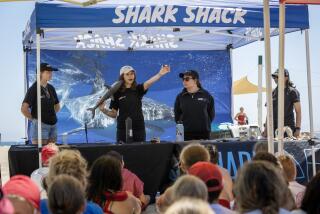WESTMINSTER : Institute Brings Sea to Schools
- Share via
Michael Dearing, 12, took one look into the dissected mackerel displayed for his class, grimaced, and announced: “This is yucky.”
But Michael appeared to hold the minority view as his classmates jostled excitedly around the table for a better view of the fish’s heart, liver and stomach. Many of the students, who had never before helped perform a dissection, were impressed and exclaimed in unison: “Whoa!”
On Thursday at Willis Warner Middle School, the 16 youngsters, most of them learning-disabled, enjoyed an unusual marine biology class offered by the Orange County Marine Institute.
Under the program, which targets the learning-disabled, instructors use a mobile classroom stocked with frozen sea creatures, whale bones and other oceanic items to teach children through hands-on activities.
The program was created four years ago to provide specialized one-day instruction at schools countywide, partly because shrinking school budgets made field trips less common. Now, since many students can’t go to the sea, the institute brings the sea to the students more than 100 times a year, said Rhoda Rafkin, an institute instructor.
“We have children all the time who have never been to the ocean. They’ve never seen a live crab,” Rafkin said.
Teacher Maryanne Hague praised the program for being geared to children who often have short attention spans. Her students “were able to focus on the lesson, which is not always easy for them. They were real attentive.”
“Hands-on. It’s what children who have special needs need,” she added.
During the class, students learned about the anatomical structures of sea creatures and how they help the animals live underwater. Activities included creating “fish prints” by painting semi-thawed fish various shades of blue and purple and then pressing them against white sheets of paper.
Then the students took turns dissecting the mackerel and a squid, an activity that inspired interest and excitement as well as squeamishness.
At one point, Rafkin displayed the foot-long squid and said, “You see it has suckers on the end of his tentacle? Why do you think he has that?”
“To grab people!” quipped Sergio Laris, 12.
“This has nothing to do with people, it’s to grab fish,” Rafkin said.
Sergio, a seventh-grader, said later that he learned more during the demonstration than he would have from listening to a lecture or reading a book.
“They showed us a lot of things about fish that we didn’t know, like, that one fish has three hearts,” he said, referring to the squid.
Joe Ochoa, 13, agreed, and added that learning was easier “because you can touch it and feel it and look inside it. It’s really cool.”
On the downside, he added: “It kind of smelled.”
More to Read
Sign up for Essential California
The most important California stories and recommendations in your inbox every morning.
You may occasionally receive promotional content from the Los Angeles Times.













